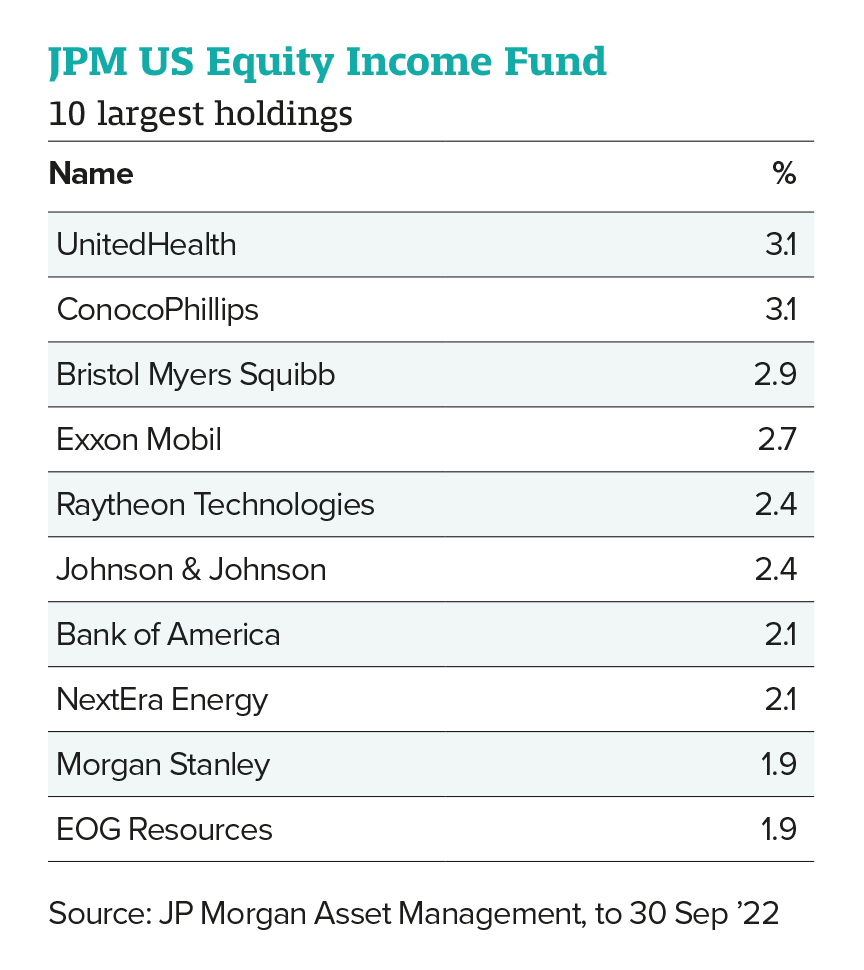It has been a difficult decade for equity income in general, the contrast with non-income funds has been particularly stark in the US. The performance of low-yielding tech giants eclipsed the plodding performance of the country’s industrial stalwarts, such as McDonald’s, Johnson & Johnson and Exxon Mobil.
In a sign of the gap between the two areas, the industrials-focused Dow Jones has delivered an annualised return of 10.4% in the past decade, while the S&P 500, which includes Alphabet, Meta and Amazon, has seen growth of 11.7% per year during the same timeframe.
Growth funds gravitated to the top of the IA North America sector, while equity income funds struggled to keep pace. However, the environment has undergone a notable shift as inflation has taken hold and the Federal Reserve raised rates. The value approach employed by many equity income funds has found favour again, and many of the technology giants that have performed so well now face increasing challenges, from regulation to innovation.
As a result, many investors have rediscovered the charms of income funds in the US, particularly when paired with a tracker. Those investors will be looking for a fund that hasn’t fared too badly during the fallow years of the past decade but has come out of the blocks quickly more recently. This has not been an easy trick to pull off. Fund managers have faced rising pressure from their bosses and investors to compromise their process and invest in technology.
Against this backdrop, the JPM US Equity Income Fund has had a number of advantages. With a large US equity franchise, there was no danger of ‘mission creep’ – if investors wanted a growth fund, they could choose the JP Morgan US Select, US Select Plus or Research Enhanced Index funds. Equally, there was no pressure to change strategy. The fund is £4.3bn in size, so had good defences.
Fiona Harris, managing director, US equities, works with Clare Hart, Andrew Brandon and David Silberman on the portfolio, and says this consistency of process has been a real advantage: “Whatever is in vogue, we turn up and do the same thing every day. We gravitate to conservative companies with a consistent pattern on earnings and we aim to buy them when they are on attractive valuations.
“We’re not trying to find deep value but high-quality businesses where, for some reason, the market doesn’t like them. We are patient – and wait for the market to come to us.”
The average holding period is five years.
But dividends are the third rung of the analysis. If a company doesn’t have the quality or valuation, says Harris, it won’t be in the portfolio. If it fulfils those criteria, the team seeks a 2% dividend yield with a low payout ratio. “While we want the dividend cheque today, we also want capital appreciation.”
US income shopping
The US is a fertile area to look for income, she says, even though its growth stocks may grab the headlines. There is a notable contrast with other markets, where income funds can be dominated by certain sectors and companies. While the process will lead them in different directions over time, it will always be well-diversified. Currently, financials are around 22% of the portfolio, followed by healthcare at 18%. Industrials, consumer staples, energy and information technology are also well-represented.
Harris says: “We can look across all industries, and that is very important. We find companies that fit our criteria across a range of sectors. Technology is not known for its dividend payouts, for example, but this has shifted over time.
“When we launched the fund in 2008, the technology weighting was zero, but we are now seeing tech companies paying more and hold around 8% of the portfolio here. This is a big underweight versus the S&P, but we also have plenty of tech-enabled companies.” She admits it has exerted a drag on performance, but adds: “It’s like the Eiffel Tower, if you go up one side, you’ve got to come down the other.”
Performance has been reassuringly consistent. Over five years, the fund is up 71%, ahead of the average for the IA North America sector (68.1%).

It has significantly benefitted from the recent market conditions: over one year, it is up 12.6%, compared with a sector average fall of 3.4%. Volatility has been low over one and three years and the fund also scores well on alpha delivery.
She adds: “Staying true to our process has been important in recent markets. This can be difficult for small firms, but we know that other people are doing growth and that’s fine. We know this product, we know its style.”
Dividends have also proved consistent. During the pandemic, only around 5% of the fund’s holdings suspended or cut their dividends. “In many cases, we felt that suspending the dividend was the right thing and they resumed them shortly afterwards. However, we did miss out on dividend growth during that period,” says Harris. This has come back with dividend growth of almost 20% in the immediate aftermath of the pandemic. Historically, 10-12% growth has been more usual.
Stockpicking versus macroeconomics
Another key differentiator for the fund has been its risk analysis. For example, the team recently took down the financials exposure of the fund because it is cognisant of the risks a recession may bring about.
“There could be credit exposure, for example, and managing those risks is important,” says Harris.
Meanwhile, she has spied increasing opportunities in healthcare. “This area had been under a great deal of pressure on returns unless a company was a Covid beneficiary. People did not have faith in a lot of the pipelines of the drug companies. It’s definitely an area where our research analysts could look deep into those pipelines. These companies were priced as if they were going ex growth. Healthcare is now our second-biggest allocation.”
It’s not about timing the market, she says, but rather about assessing the opportunities relative to their price. “Covid gave us the opportunity to increase our industrial exposure as a lot of these companies started to get priced down. We’re patient, we know what we’re looking for and the market will give us opportunities. We added 15 names in 2020; this year, we’ve only added four.” The group’s long-term lens helps it uncover specific areas where there is a disconnect between the market’s view of a company and its prospects.
While the group is firmly in the stockpicking camp, it recognises that companies do not exist in a vacuum. The team uses macroeconomic analysis to assess risk rather than select stocks. Harris says that using it to select stocks can be misleading: “If interest rates are rising, logic suggests we should be buying banks. But if rates are rising, inflation is rising. Nothing happens in isolation. Rising rates may help with banks’ margins but investors need to factor in all the other risks. At the moment, banks are making greater loan loss provision and mortgages rates are rising to levels not seen in a long time.”
The situation today
Harris says though markets are in a gloomy mood there have been pockets of good news largely overlooked by investors. For example, McDonald’s increased its dividend for the 46th year in a row in October, but markets greeted it with a shrug.
Equally, she says, there isn’t significant duress among the companies in the portfolios. “The market likes quality companies at the moment, with low debt and good balance sheets. It recognises that this type of business should be in a better position to navigate the complexities of this economic environment.”
However, the team is alert to the unknowns and recognises it is important to look under the hood. There have been some concerns that as bond yields rise it could cut off the nascent rally in equity income funds. For some time, the ‘Tina’ (there is no alternative) provided a strong support for equity markets. Income seekers, in particular, had no choice but to look at the stock market. This prompted a vogue for ‘bond proxies’ – stable dividend-paying companies that offered the reliability of a bond.
Harris acknowledges the risk of a reverse bond proxy trade as bond yields rise. However, she believes it would probably be areas such as utilities that would suffer most. “Bond yields are starting to look good and, for the first time in a long time, are higher than the S&P 500. There is now an alternative where there was none. Utilities tend to grow in line with the economy and would maybe be the first area to suffer if there is an anti-bond proxy trade.” Utilities still form part of the portfolio, but only around 5%.
As investors reappraise their US holdings in light of a higher inflation, higher interest rate world, US equity income is coming back into vogue. The JPM US Equity Income Fund may have benefited from a rising interest rate environment, but its style and process should outlast the current twists and turns of the Federal Reserve.
BIOGRAPHY
Fiona Harris, managing director, is an investment specialist in JPMAM US equities. An employee since 1997, she is responsible for communicating investment strategy, portfolio information and results to non-US domiciled clients. Previously, Harris was a client portfolio manager in the firm’s New York office, where she provided support on the mid-cap value strategy. She joined the firm as a marketing associate focusing on servicing the needs of clients in the UK and continental Europe.
This article first appeared in the November edition of Portfolio Adviser Magazine







